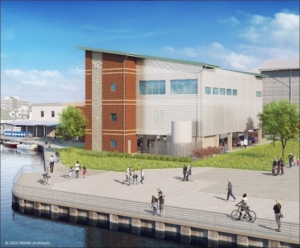A New Home for the Heart of Virginia’s Seafood Industry
Virginia’s seafood industry has an economic impact of more than $550 million on the commonwealth. With such huge resources at stake, the seafood industry needs to be ready to adapt to global markets and new technologies. That’s why the Virginia Seafood Agricultural Research and Extension Center (AREC) is getting a huge new building.

“An architectural rendering of the new Virginia Seafood Agricultural Research and Extension Center in Hampton, Virginia.” Credit: RRMM Architects, 2019
The AREC serves as a hub of research, technology, and marketing of Virginia seafood. The team is currently housed in a refurbished oyster processing building in Hampton, but it’s rapidly deteriorating and even floods during storms.
U.S. Secretary of Commerce Wilbur Ross announced in September that AREC will receive an $8.4 million grant to build a new 21,700-square-foot facility in Hampton. The new facility is expected to retain 408 jobs.
It will have “expanded seafood processing and microbiological laboratories, upgraded food fish and ornamental research facilities and water chemistry labs, expanded classrooms, outreach and training facilities, and additional workstations and housing for visiting faculty, students, and industry collaborators,” according to a fact sheet about the project.
Virginia Tech reported, “The AREC’s mission is to conduct applied research, produce crucial information, develop modern technologies and new techniques in support of the seafood industry, and to share that knowledge with stakeholders who rely upon it for their success.”
The space will be utilized by a range of partners, including the Virginia Institute of Marine Science, the College of William and Mary, Hampton University, Virginia Sea Grant and all associated University Consortium Members, local Community Colleges, Peninsula K-12 Schools, Virginia Air and Space Museum, and more.
“At the Virginia Seafood AREC, we view ourselves as partners with the seafood industry, and we constantly work together to find ways to help it succeed and remain sustainable,” said Michael Schwarz, director of the Virginia Seafood AREC. “This new building, and its significantly enhanced capacity, will allow us to continue to do so in ways that will benefit our partners for decades to come.”
